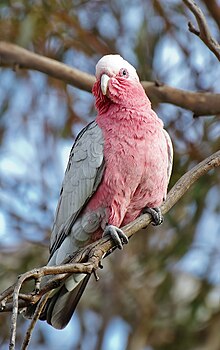Eolophus
| Galah | |
|---|---|
 |
|
| Male, In Tasmania, Australia | |
| Scientific classification | |
| Kingdom: | Animalia |
| Phylum: | Chordata |
| Class: | Aves |
| Order: | Psittaciformes |
| Superfamily: | Cacatuoidea |
| Family: | Cacatuidae |
| Subfamily: | Cacatuinae |
| Tribe: | Cacatuini |
| Genus: |
Eolophus Bonaparte, 1854 |
| Species: | E. roseicapilla |
| Binomial name | |
|
Eolophus roseicapilla (Vieillot, 1817) |
|
| Subspecies | |
|
E. r. roseicapilla |
|
 |
|
| Galah range (in red; all-year resident) | |
| Synonyms | |
|
|
E. r. roseicapilla
E. r. assimilis
E. r. kuhli
The galah /ɡəˈlɑː/ (Eolophus roseicapilla), also known as the rose-breasted cockatoo, galah cockatoo, roseate cockatoo or pink and grey, is one of the most common and widespread cockatoos, and it can be found in open country in almost all parts of mainland Australia.
It is endemic on the mainland and was introduced to Tasmania, where its distinctive pink and grey plumage and its bold and loud behaviour make it a familiar sight in the bush and increasingly in urban areas. It appears to have benefited from the change in the landscape since European colonisation and may be replacing the Major Mitchell's cockatoo in parts of its range.
The term galah is derived from gilaa, a word found in Yuwaalaraay and neighbouring Aboriginal languages.
Galahs are about 35 cm (14 in) long and weigh 270–350 g. They have a pale silver to mid-grey back, a pale grey rump, a pink face and chest, and a light pink mobile crest. They have a bone-coloured beak, and the bare skin of the eye rings is carunculated. They have grey legs. The sexes appear similar, however generally adult birds differ in the colour of the irises; the male has very dark brown (almost black) irises and the female has mid-brown or red irises. The colours of the juveniles are duller than the adults. Juveniles have greyish chests, crowns, and crests, and they have brown irises and whitish bare eye rings, which are not carunculated.
Galahs are found in all Australian states, and are absent only from the driest areas and the far north of Cape York Peninsula. It is still uncertain whether they are native to Tasmania, though they are locally common today, especially in urban areas. They are common in some metropolitan areas, for example Adelaide, Perth and Melbourne, and common to abundant in open habitats which offer at least some scattered trees for shelter. The changes brought by European settlement, a disaster for many species, have been highly beneficial for the galah because of the clearing of forests in fertile areas and the provision of stock watering points in arid zones.
...
Wikipedia

